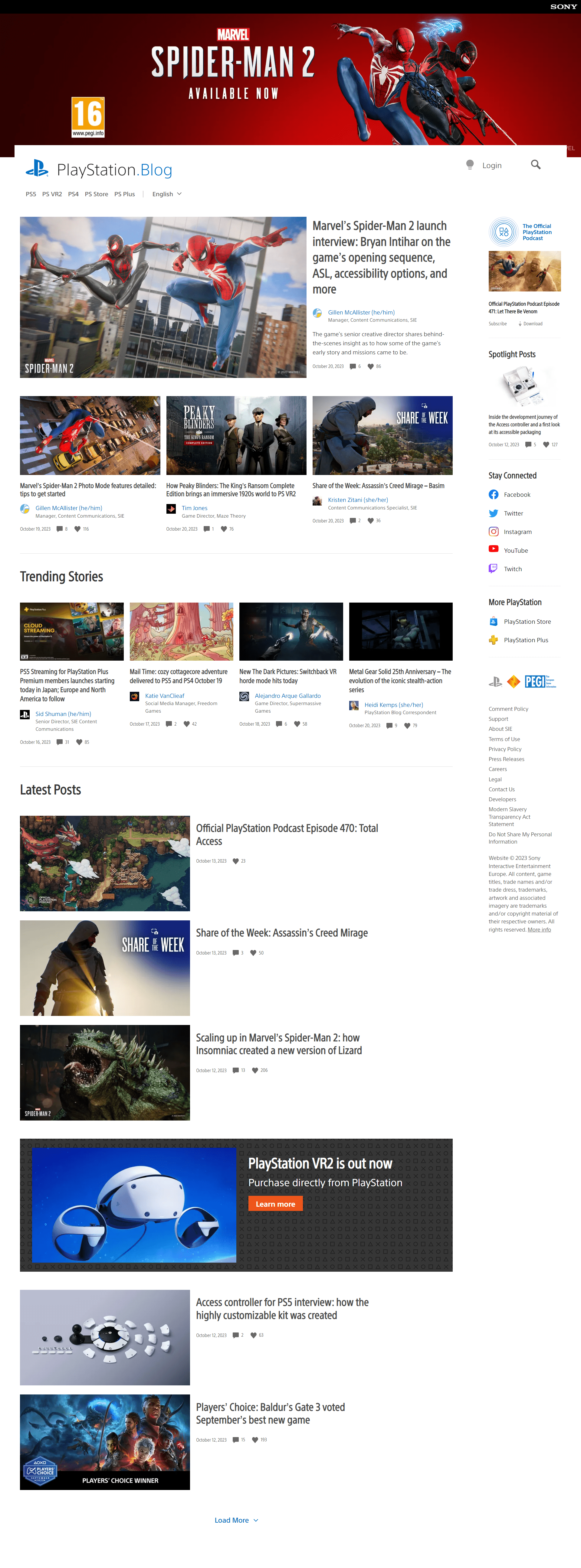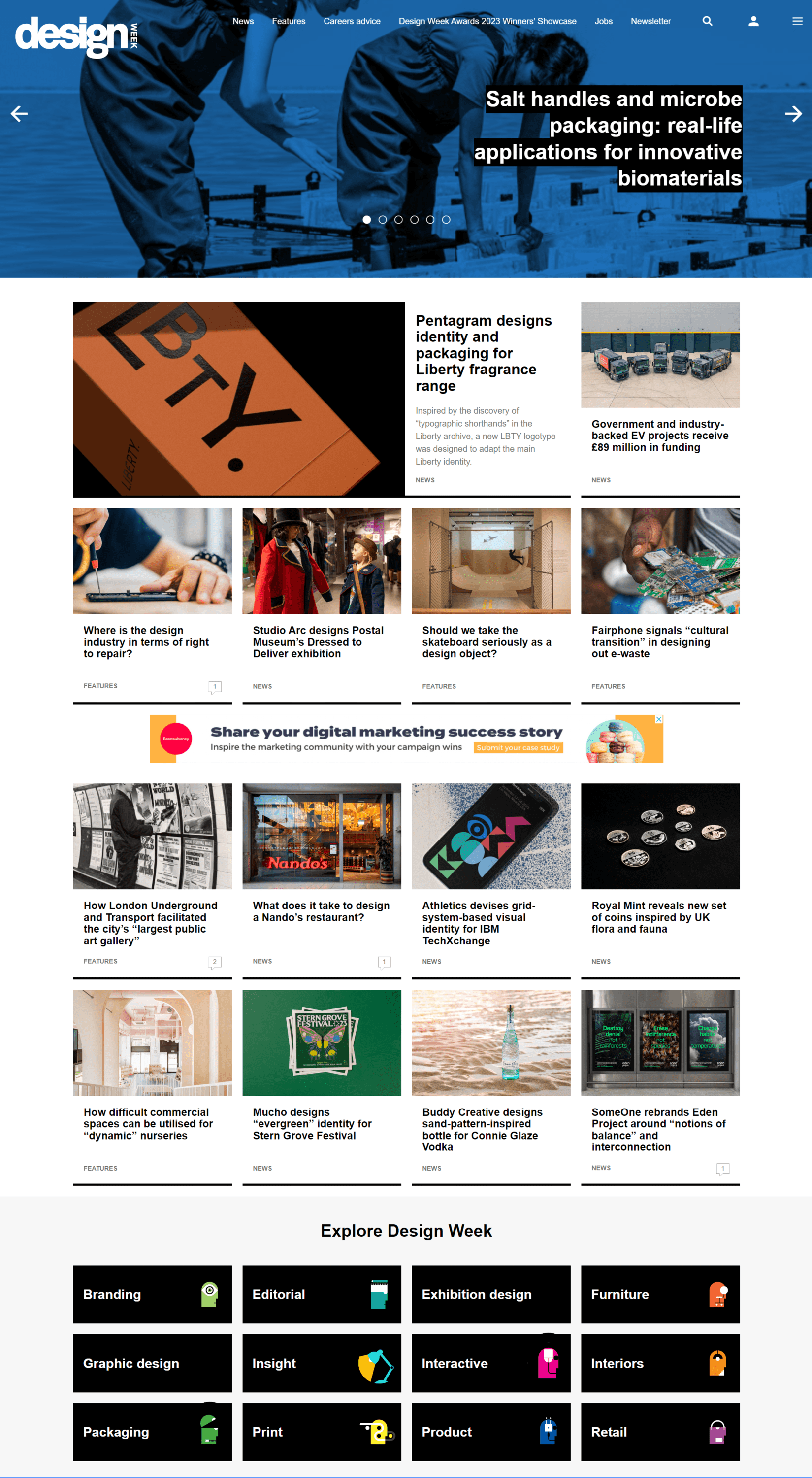The 9 Most Popular Types of Websites to Make [+Examples]
Today, people spend a large amount of their time online, so online presence is crucial for businesses. Having their own website allows companies to interact with potential customers more effectively and implement digital marketing strategies for development. It’s a sure way to increase visibility, earn the trust of your audience, and increase sales in the long run.
At the same time, it’s important to know that there are many types of websites aimed at achieving different goals. To help you choose the best option for your business, we’ll explore different website types and their key features. Keep reading to learn more!
![The 9 Most Popular Types of Websites to Make [+Examples]](https://depositphotos-blog.s3.eu-west-1.amazonaws.com/uploads/2023/10/types-of-websites.jpg)
The main types of websites with examples
1. E-commerce websites
2. Corporate websites
3. Blogs
4. Landing pages
5. Portfolio websites
6. Online services
7. Entertainment websites
8. Informational websites
9. Forums
1. E-commerce websites
E-commerce websites are the same as online stores. They enable businesses to sell physical and digital goods or services online. Such types of web pages allow you to accept orders and payments, manage delivery, and provide customer service. In fact, any site where you can buy goods is considered an e-commerce site.
The main tasks of an e-commerce website include:
- increasing conversion rate;
- improving brand awareness;
- attracting visitors;
- increasing customer satisfaction;
- retaining regular customers.
E-commerce website features
- User-friendly design. A good user experience is an integral part of a well-designed e-commerce website. Hence, it is important to pay special attention to the development of a clear layout, easy-to-use navigation, and search.
- Adaptivity. With the rapid growth of mobile commerce, optimizing e-commerce sites for different devices is one of the top priorities. Using adaptive design, you get the opportunity to improve customer satisfaction and increase conversion rates.
- Various payment options. To increase the chance of a purchase, offer customers a convenient payment process. Along with traditional payment methods by card or bank transfer, you can add digital wallets, payment systems such as PayPal and Payoneer, cryptocurrency payments, etc.
- Customer support. High-quality support helps retain customers, which is much more profitable than attracting new ones. To respond to questions and requests from visitors as quickly as possible, consider integrating a chatbot with 24/7 support.
- Well-thought-out catalog. Your catalog should be appealing and informative to engage users and motivate them to make a purchase. This includes both detailed product descriptions and high-resolution images that allow customers to see everything clearly.
Remember that you can always use a free background remover and image upscaler to get high-quality visual content for your online store. If you’re looking for ready-to-use images, check out our library of over 270 million files.
E-commerce website types and examples
- Monobrand websites are the online stores of individual companies; they promote only their own products or services. Here are some examples of such stores: Nike, Fenty Beauty, and IKEA.
- Marketplaces are large online platforms where goods or services can be sold by third parties. The best-known examples of such websites are Amazon, eBay, and Walmart.
- Online retailers are multi-brand websites or online stores. Unlike monobrand stores, they offer products from different companies. Here are some examples of online retailers: Macy’s, Sephora, and Nordstrom.
- Affiliate websites also sell the products of other brands, but they do it in exchange for a commission fee. Well-known affiliate websites are NerdWallet, Verywell Fit, and Skyscanner.
Thinking of launching your own e-commerce website? First, check out our step-by-step guide “How to Open an Online Store”.

Source: eBay
2. Corporate websites
The main goal of a corporate website (or a business website) is to promote a particular business and its goods or services. It contains important information about the company, its activities, advantages, offers, and terms of cooperation. This website format also makes it possible to accept online orders, receive feedback, and collect data on the target audience.
There are some mandatory sections that corporate websites can’t do without:
– the company’s info;
– a description of products and commercial offers for customers and partners;
– cooperation terms;
– contact info.
Despite the common opinion that a corporate website and an e-commerce website are interchangeable; this is not the case. The main difference is that e-commerce sites are primarily designed to provide online purchases, while corporate website types cover all business activities and services provided via the Internet.
The main tasks of a corporate website include:
- presenting the company;
- shaping the company’s image and managing its reputation;
- expanding the customer and partner base;
- promoting products and services;
- attracting new employees.
Corporate website features
- Simple email address. To make it easy for users to find your site, it’s important to create a simple address that includes your company name.
- Brand identity. Since a corporate website carries out important image tasks, it should be in line with your company’s brand identity. The logo, corporate colors, images—all of these elements should reflect the nature of your brand and maintain its consistency.
- Convenient feedback system. Offer a variety of communication options to increase the chances of interacting with potential customers or partners. Feedback options can include phones, email, messengers, and online chat.
- Quality content. Here, we are speaking about offering the audience some added value. Interesting and useful content will motivate visitors to come back to your site and improve its position in search results.
Types of corporate websites
- Business card websites are small websites with one or several pages that contain only basic information about a company or a person. They are suitable for small businesses and people who want to present themselves as professionals.
- Catalog websites offer detailed information about products and services, as well as options for contacting company managers. This website type is a good option for companies that cannot publish up-to-date prices for various reasons (for example, due to exchange rate fluctuations).
- Web portals are designed to build a community around a brand or an interest group, and usually contain feature articles, tips, news, or practical lessons.
Examples of corporate websites: Apple, Cadbury, Adidas Group

Source: Apple
3. Blogs
A blog is a regularly updated website with content on a specific topic. Blog posts can be either purely textual or supplemented with images and multimedia files. These types of websites allow for feedback from the audience; a blog’s feature set often allows readers to leave comments under posts.
Today, the concept of blogging is primarily associated with individual bloggers who create and distribute original content to reach a large audience and monetize their activities. However, businesses can also benefit a lot from blogging.
The main tasks of blogs include:
- driving traffic to the company website;
- natively promoting goods and services;
- building strong relationships with the audience;
- demonstrating expertise;
- building a community around the brand.
Blog features
- Modern layout. The blog’s layout should be convenient and appealing in order to make visitors want to read and spend as much time on the site as possible.
- Subscription option. Place your blog newsletter subscription form in a visible place to motivate readers to be the first to know about new posts.
- Social media integration. Since a large share of blog traffic comes from social media, add buttons to easily share your content on social platforms.
- Categories and search. Improve the user experience by enabling visitors to easily find the content they need through categorization, tagging, and optimized search.
- Reverse chronological order. To ensure that readers have immediate access to the most recent posts and news, all content on the blog is arranged in reverse chronological order.
One of the keys to success for any blog is content. This includes both the textual content of your articles with catchy headlines and eye-catching images that should motivate readers to open the article. A reliable source of such images is Depositphotos’ curated collections, where you can find trending content for your blog on any topic.
Types and examples of blogs
There are many classifications of blogs — from topic-based to format-based ones. But in the context of authorship, there are two most common types of blogs, personal and corporate.
- Personal blogs are usually written by one person who shares their thoughts, ideas, and experiences. They can cover any topic and have an informal tone of voice. Examples of personal blogs are Minimalist Baker and the blogs of Austin Kleon and Neil Patel.
- Corporate blogs can be run by different authors. The main topic of these sites is the company itself and its products or services. The purpose of corporate blogs is to make visitors interested in the content and then move through the sales funnel to the call to action. Examples of such websites are the blogs of Hootsuite, Etsy, and PlayStation.

Source: PlayStation
4. Landing pages
A landing page is a small website or a website page designed to motivate a visitor to perform a certain targeted action: make a purchase, register, subscribe, etc. Usually, it is a single page that contains the necessary information about a product or service. Its main difference from a corporate website type is that a landing page has no additional sections, only text, visual content, and buttons. Everything is designed to focus the user’s attention on the desired action.
The main tasks of landing pages include:
- convert visitors;
- collect email addresses;
- offer a trial period;
- offer registration for an event;
- promote a special offer.
Landing page features
- Compelling headline. The headline is the first thing landing page visitors see. It should grab attention and at the same time clearly convey what the user can find on this page.
- Readable and understandable text. The easier it is for visitors to read and digest landing page content, the more likely you will succeed. Therefore, rely on concise text and legible fonts.
- A visible lead form. A lead form is one of the main elements of a landing page; it allows you to collect desired contact information or applications. Make the form noticeable and as short as possible, because the less information a user needs to enter, the more likely they are to do so.
- Strong call-to-action. Since the main purpose of a landing page is to motivate visitors to take action, the CTA should be clear and stand out to attract attention.
- Structured content. To convey a message in the best possible way, it is important to structure the landing page text into semantic blocks. You can do this using white space, positioning, or a background.
Want to learn more about how to achieve the best results using this website format? Check our complete guide to creating high-converting landing pages.
Landing page types
- Lead generation landing pages should motivate users to subscribe to updates or get a demo version by providing their contact information. To do this, marketers use a lead form and a lead magnet, which means they offer some value for contacts such as useful content or a discount.
- Click-through landing pages should encourage visitors to click through to another page. As a rule, this is a product or subscription page. Such types of website design are often used by e-commerce sites specializing in quick sales.
Examples of landing pages: Airbnb, Uber, Spotify

Source: Uber
5. Portfolio websites
A portfolio website is an online resource that presents a collection of works or projects of a professional. The main purpose of such websites is to demonstrate the level of professionalism of the owner and to promote their services. This is a reliable way to find potential employers or customers and earn credibility in your field. Portfolio sites are often used in the creative sphere by designers, architects, photographers, copywriters, etc.
The main tasks of portfolio websites include:
- presenting the best projects;
- attracting customers;
- creating a personal brand;
- help in finding new job opportunities;
- improving trust.
Portfolio website features
- Gallery of works. You should focus on quality, not quantity, and pick only the best works. At the same time, it is advisable to showcase diverse projects that reflect a wide range of your knowledge and skills.
- Relevant design. The graphic design should harmoniously complement the works in the portfolio and, if possible, enhance them. This includes the choice of colors, images, buttons, and other design elements.
- “About me” section. No matter how eye-catching the works in the portfolio are, visitors will be interested in learning more about the person who created them. In your bio, you can share your story or talk about your work.
- Contacts for communication. Contact information should be clearly visible so that people who want to contact the site owner can easily find it. This significantly increases the chances of attracting customers.
- Social links. Social platforms increase your online visibility and offer additional ways to communicate. You can also add a “Share” button so that visitors can share your work on their social pages.
Find even more ideas for an impressive portfolio in our article “How to make a creative portfolio: tips, advice and inspiration”.
Examples of portfolio websites: portfolio of Cristiano Ronaldo, Helen Mirren, Stefan Sagmeister

Source: Stefan Sagmeister’s website
6. Online services
These are website types that provide users with services or allow them to perform certain actions online. This can include making payments, shopping, working with content, etc. For example, our free image background remover also falls into this category. Online service can be either a separate website or a section of a website, like a blog or landing page.
Online service features
- Clear description. Users should clearly understand what services you offer and what actions they need to take to get desired results. The simpler you explain your offer, the better.
- Uninterrupted operation. Slow loading and malfunctions can severely spoil the impression of your service. Carry out the technical optimization of your website to avoid such situations.
- Prompt support. Most likely, your customers will have questions about how to use the service. Provide quick feedback options by adding different communication channels (phone, email, bot, messengers) so that all problems can be resolved as quickly as possible.
- Description of benefits. Your service is unlikely to be unique, so it’s worth taking the time to compile a list of key arguments for why users should choose it over your competitors’ products. Think about your unique selling proposition.
- FAQ section. To answer all the frequently asked questions that users may have while working with your service, combine them into one document and place a link at the bottom of your page. This way, visitors can easily find them if necessary.
Types and examples of online services
- Online search services, as the name implies, allow you to search for the information you need. These include search engines, online libraries, catalogs, directories, and online translators. Examples of online search services are Google, Bing, and Deepl.
- Online social services include social platforms, messengers, and email services. You can use them to communicate, share content, and much more. Some examples of such online services are Instagram, TikTok, and LinkedIn.
- Banking services are designed for performing payment transactions. You can use them to pay for purchases or utilities without visiting a bank in person. Today, most banks have convenient online payment services.
Source: Image Upscaler
7. Entertainment websites
Entertainment websites are online platforms based on entertainment content. This can be images, stories, jokes, tests, horoscopes, videos, music, games, etc. The purpose of such a website type is to give visitors vivid emotions and an exciting leisure option. Since entertainment sites are quite popular and usually have high traffic, there are many opportunities to monetize them—from referral programs to advertising and affiliate programs.
Entertainment website features
- Engaging content. Since content is what visitors come for, its quality and variety should be a priority. Offer a variety of formats and update the site regularly so that users know they will always find something interesting.
- User-friendly interface. A well-designed entertainment website should have a user-friendly interface that allows visitors to navigate easily. Therefore, rely on a neat layout and an intuitive menu.
- Mobile adaptivity. Due to the convenience of mobile devices, more and more people are using them to surf the web and consume content. Make your website design adaptive to ensure an uninterrupted viewing experience, regardless of the devices your visitors use to browse through it.
- Social media integration. This point is crucial for any entertainment website. The ability to share content increases the reach and visibility of your site and promotes effective engagement.
- Search engine optimization. Make sure you optimize your content to improve your site’s visibility for search engines and get more traffic. SEO is the basis of successful digital marketing, which opens up monetization opportunities.
Entertainment website types and examples
- Video platforms. These include online movie theaters, also called streaming services, and video hosting services. These are some of the most visited websites in the market. The most popular video platforms include YouTube, Netflix, and Amazon Prime.
- Music platforms, also called music streaming services, allow artists to share their music and other audio content, while users can search and listen to it. Common examples of such websites are Spotify, Apple Music, and SoundCloud.
- Entertainment platforms. This category includes sites like BuzzFeed, which contain a large amount of diverse content, from celebrity news to DIY tips.

Source: Spotify
8. Informational websites
The main task of informational websites is to provide visitors with interesting and useful information. For example, it can be an online industry publication or a news site. Such types of web pages usually do not sell goods or services. However, they can earn money by placing ads and affiliate materials.
Informational website features
- Easy navigation. Along with convenient search, you should make well-thought-out categorization and tags that will allow users to find relevant information easily and quickly.
- Expert content. Informational websites require in-depth analytical content that demonstrates a level of expertise and shows that the author’s opinion can be trusted.
- Interactivity. Not only should informational sites share valuable content; they should also provide a feedback option in the form of comments and discussions.
- Convenient subscription. To grow your user base, place the subscription form in a prominent place. You can also offer subscription bonuses, for example, in the form of a guide, e-book, or webinar.
Informational website types and examples
- Thematic websites, as the name implies, are dedicated to a specific topic, be it marketing, design, finance, technology, art, etc. Examples of such sites include Design Week, which talks about design and architecture, and the British Journal of Photography.
- Informational portals cover not just one area, but several at once. Examples include The Drum, a website dedicated to marketing, advertising, and media, as well as Creative Boom, where you can find a lot of interesting information about various creative industries, from design to the fashion and film industry.
- News websites. These platforms spread information about important events. At the same time, they can also have a certain theme and publish only certain types of news, for example political, economic, or sports news. Examples of well-known news sites are CNN and BBC.

Source: Design Week
9. Forums
Forums are platforms intended for online communication. These sites create topics for discussion, and anyone can freely join in. Forums have administrators (owners) and moderators who monitor adherence to the rules. Similar to blogs, forums can be either independent resources or sections of websites.
Forums features
- easy registration. Motivate your visitors to start using your platform by adding quick registration via email or social accounts.
- user-friendly structure. Make sure your forum layout and sections make it easy for visitors to find relevant topics. This is the basis of their satisfaction and high-quality user experience.
- intuitive interface. It should be obvious to visitors how to use the forum, namely how to start a discussion, answer or ask a question, edit a response, etc. Make sure that all the tools are simple and user-friendly.
- clear rules. You definitely don’t want your forum to be a place that is spreading intolerance, hatred, or any kind of discrimination. Set clear rules, including taboo topics and unacceptable behavior, and enforce them.
- effective engagement. Add some interactivity to your forum using polls and voting. You can also introduce user ratings based on their activity to create a game element and encourage more active engagement.
Forum types and examples
Forums differ in many ways, from structure to format, but according to general classification, they have two main types:
- Thematic forums. As the name suggests, these are more niche versions of forums that bring people together by interest. Such online platforms can pertain to any topic. For example, there are dedicated forums for World of Warcraft and people who rent their homes through the AirBnb service. Such forums are a great way to create community around the brand.
- General discussion forums. Unlike thematic forums, these have no restrictions on topics, so users can discuss any issues of interest there. Well-known examples of general discussion forums are Reddit and Quora.

Source: World of Warcraft
To wrap up
Given the wide range of websites that exist today, every business can find the best option to improve brand visibility and achieve other marketing goals. Since your website is your online visiting card and sometimes the main channel of interaction with your audience, make sure it presents your company in the best way possible, conveying its unique character and values. Focus on a user-friendly experience and high-quality content to make visitors come back to your site again and again.
FAQ
What is the most common website type?
Some of the most common websites are corporate or business websites, as well as online stores. Today, 71% of businesses have a website. With the development of e-commerce, this figure is growing rapidly, so it’s no surprise that according to the latest data, a new website is built every three seconds.
How many types of websites are there?
There are a lot of website classifications. And some of them include dozens of website types. But if we look at the main types, these are business sites, including corporate and online stores, landing pages, blogs, portfolio sites, online services, informational and entertainment sites, and forums.
What types of websites make the most money?
If your goal is to profit, you should consider websites intended for active sales. These are primarily e-commerce and corporate websites. If you are interested in quick sales, landing pages can also be handy. Read our article to learn more about the potential of this website type: “The complete guide to creating high-converting landing pages”.
Other articles you might find interesting
How to open an online store in 2023: a step-by-step guide
What is Digital Design? A Comprehensive Guide on its Types, Tools, and Best Practices
Details Matter: How Microinteractions Enhance Interfaces & User Experience












